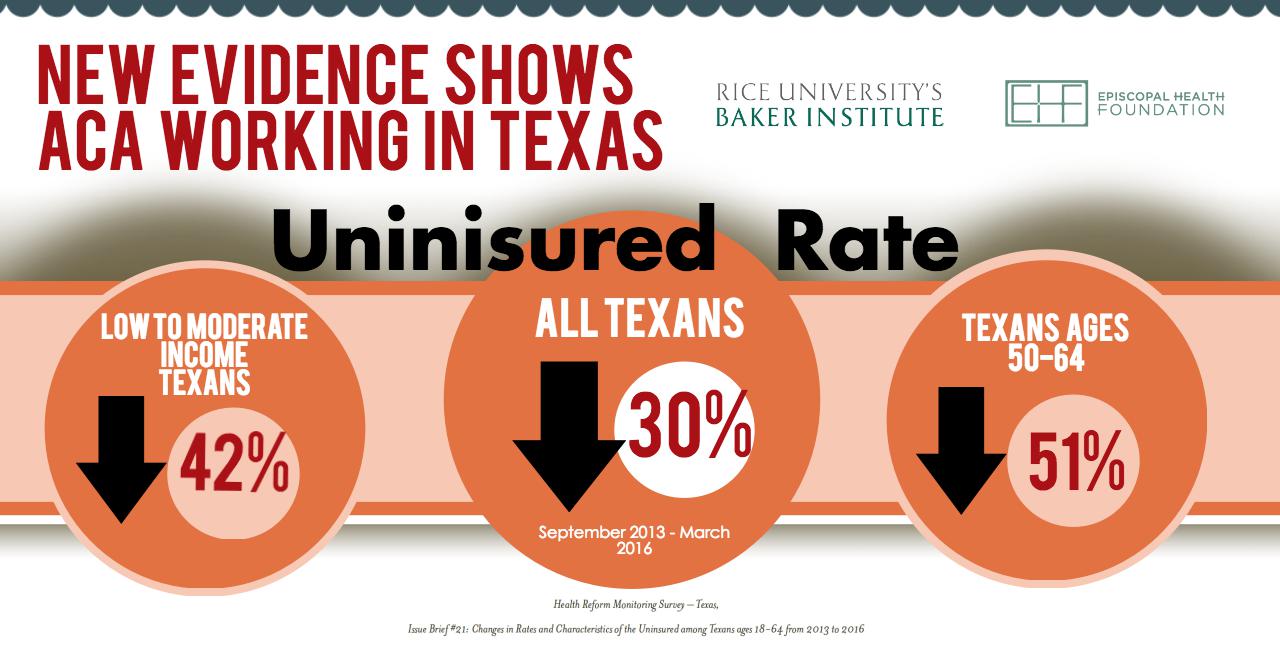
The percentage of Texans without health insurance has dropped by 30 percent since the Affordable Care Act (ACA) went into effect, cutting the state’s uninsured rate below 1999 levels. That’s one of the conclusions of a new report released by the Episcopal Health Foundation (EHF) and Rice University’s Baker Institute for Public Policy.
The report found the uninsured rate among Texas adults dropped from 26 percent in September 2013 to 18 percent in March 2016. Researchers also discovered a steady decline in the uninsured rate for every age, ethnic and income-level group across the state.
“These latest numbers confirm the continuing downward trend in the number of uninsured Texans that began as the ACA was implemented,” said Elena Marks, EHF’s president and CEO and a nonresident health policy fellow at the Baker Institute. “For more than a decade prior to the ACA, the uninsured rate remained above 20 percent and was rising. It’s now clear that it’s moving in the opposite direction, and the ACA deserves the credit.”
Click to read EHF’s complete research report
The report found that Texans between the ages of 50 and 64 experienced the largest decrease in their percentage of uninsured. The group’s uninsured rate plummeted from 21 percent to 10 percent since the ACA went into effect — a drop of more than 51 percent.
“For the older group, the ACA made health insurance much more affordable, because the law limits insurers from charging older adults no more than triple the cost for the same health insurance plans as younger adults,” said Vivian Ho, the chair in health economics at the Baker Institute and director of the institute’s Center for Health and Biosciences, a professor of economics at Rice and a professor of medicine at Baylor College of Medicine. “However, limiting premium variation by age made Marketplace policies less attractive to younger adults, which is why their uninsured rate fell less.”
Researchers also found the percentage of uninsured Texans who earned annual incomes between $16,000 and $47,000 dropped by more than 42 percent. The group’s uninsured rate declined from 23 percent in 2013 to 13 percent in 2016.
“Texans with low to moderate incomes were able to use federal subsidies to help pay for health insurance premiums for ACA Marketplace plans,” Ho said. “Those subsidies made coverage affordable for many who could not have purchased plans without that help.”
In fact, Ho and Marks note that the U.S. Department of Health and Human Services reports that 84 percent of the 1.3 million Texans now enrolled in ACA Marketplace health insurance plans received subsidies to help pay for premiums.
Researchers said that while it’s evident the ACA has helped drop the uninsured rate in Texas, it’s also clear that a significant number of Texans with the lowest incomes remain uninsured. The report found that 46 percent of Texans earning less than $16,000 a year don’t have health insurance.
“The ACA as implemented in Texas offers little hope for Texans with the lowest incomes,” Marks said. “They make too much to qualify for traditional Medicaid and not enough to get a subsidy to help pay for their premium. They’re stuck in the ‘coverage gap,’ and unless Texas expands Medicaid or comes up with another system of coverage for this group, they will remained uninsured.”
According to the report, the “coverage gap” affects mostly people of color in working families and was recently estimated by the Kaiser Family Foundation to include 766,000 Texans.
The report is the 21st in a series on the implementation of the Affordable Care Act in Texas co-authored by Marks and Ho.
The Health Reform Monitoring Survey (HRMS) is a quarterly survey of adults ages 18-64 that began in 2013. This report is a summary of data extracted from the HRMS surveys in Texas administered between September 2013 and March 2016.
The HRMS is designed to provide timely information on implementation issues under the ACA and to document changes in health-insurance coverage and related health outcomes. The Baker Institute and EHF are partnering to fund and report on key factors about Texans obtained from an expanded, representative sample of Texas residents (HRMS-Texas).
The HRMS was developed by the Urban Institute, conducted by GfK and jointly funded by the Robert Wood Johnson Foundation, the Ford Foundation and the Urban Institute. The analyses and conclusions based on HRMS-Texas are those of the authors and do not represent the view of the Urban Institute, the Robert Wood Johnson Foundation or the Ford Foundation.